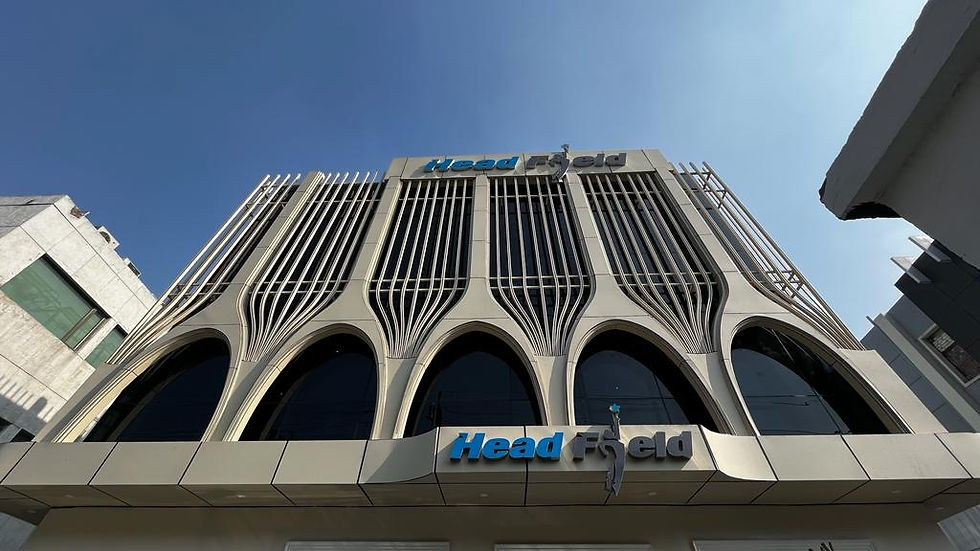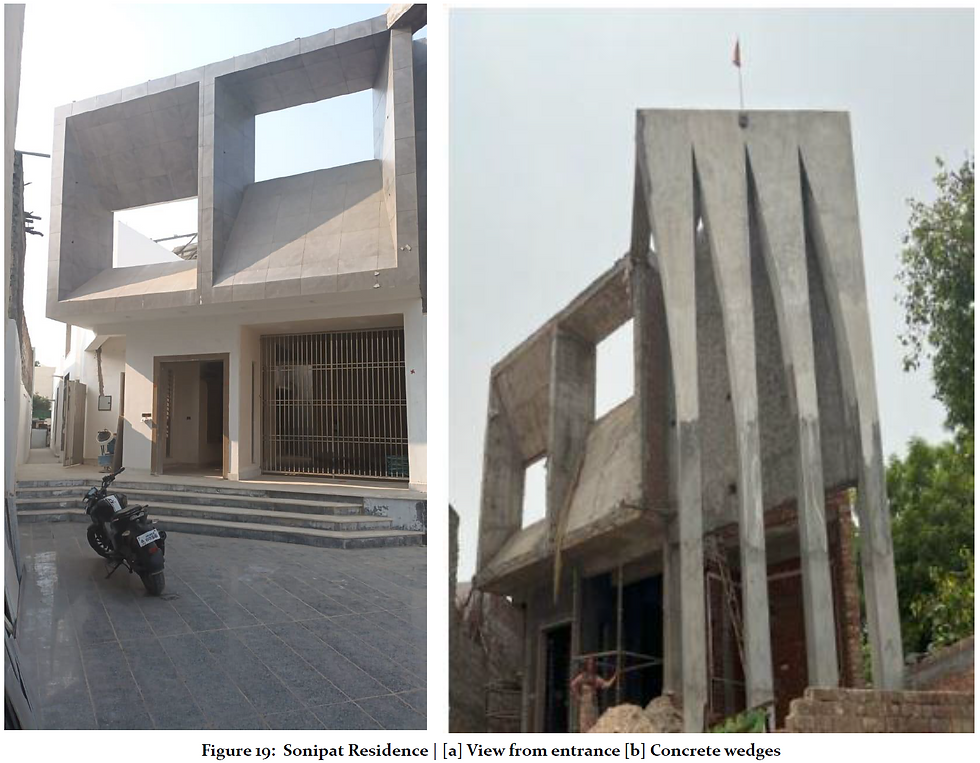Facades that speak the language of innovation to create a unique identity and iconicity!
- ratlab2012
- Dec 20, 2023
- 5 min read
Updated: Jan 3
Façade design is a vital part of every architectural project and needs to be approached through an analytical study of multiple parameters like privacy, materials and environmental factors like sunlight, from which the final outcome emerges. Parametric facades further utilize responsive design to adapt to site conditions by exploring complex geometries, digital fabrication and other cutting-edge technologies. Making use of best materials and complex geometry together with the aid of machines and computational tools, it is now possible to create unique, captivating façade profiles.
Some of the rat[LAB]’s recent projects showcase how architecture can be influenced by technology, sustainability and creative design thinking in this regard. The architectural industry is witnessing a substantial shift in methodology and expression as technology and computational tools are becoming more accessible and more utilized. While the integration of advanced technology and captivating aesthetics set these projects apart, it is important to understand and perceive the design processes behind different design problems that generated explicit solutions.

The Headfield office in Noida by rat[LAB] studio is a visionary office project design featuring a parametric façade with adaptive vertical fins made from aluminium composite panels. The dynamic façade transforms with natural light to regulate temperature and lighting within the workspace while also preserving privacy. One of the recent projects from the studio with parametric façade to be fabricated digitally, the energy-efficient shifting façade with its captivating intertwining arches is also an attempt to establish a higher standard for innovation and aesthetics in office design.

Different forms and connections were designed and tested for efficiency and aesthetics. A curvilinear interlinking of fins, lateral screens of wedged flat plates and mild variable screening were studied. The final outcome combines the effective attributes in these studies to create a unique, easy to construct, sustainable solution.
A parametric façade with vertical fins blending seamlessly to form arches, the fluid structure maintains interior-exterior visibility and has definitive construction modularity. As the adaptable façade transforms with natural light, it renders a captivating visual interplay between the outer environment and the office interiors. The dynamic vertical fins respond intelligently to sun path to create a warm and vibrant ambiance within the workspace.

The façade is a symphony of linear geometries that generates a play of light and shadow within the background. Starting from a flat canopy, five catenary arches curve upwards on the first floor and from the centres a bold axis up to the top of the structure. Spaces between these five primary units are filled uniformly by slender fins made of mild steel creating a receptive screening for the remaining upper walls.
The fabrication involves a mild steel skeleton for the arches and the fins bolted to the main structure via anchoring bolts that hold the façade elements tightly in place and takes the load of the façade elements onto the main structure. The curvilinear skeleton of the arches are covered with aluminium composite panels while the fins are given a glazed coating that aligns with the shining quality of the entire façade.


Differential lighting is an auxiliary dynamic feature provided within the linear system. Eight combinations of two lighting fixtures varying between fins and arches are provided as each can generate diverging highlights to meet the varied preferences of the client. The rope lights on fins are white, 4000Kelvin while those around the arches are 3000Kelvin. An additional uplighter from the canopy of 3000Kelvin are also added to the foot of the arches to light.


Façade design is often restricted as an added second screen to an already constructed structure. An integral part of a building as the transition zone between the internal and external environments, a façade can also be integrated in to the base structure of the mass. The Akaya One in Gurgaon is a landmark building as a high-rise structure with its bold fusion of glass and metal elements located at crossroads.


The façade of this structure therefore demands to be a visual masterwork that needs to address the rising concern for energy efficiency while also delivering incredible panoramic views to the exterior. The metal ‘A’ façade marks the focus with its bold contrast to the otherwise transparent wall without compromising views to the exterior. Akaya ONE is a high standing symbol of a synergy between architecture and technology standing tall in the city of New Delhi that utilizes minimum façade elements to achieve a direct statement.

In an upcoming project in Patel Nagar, rat[LAB] studio explores parametricism with computational design to craft a responsive façade for a business office. Concerns about construction, budget and materiality is resolved by employing lightweight metal with fibreglass infusion. Like in the Headfield office, a grid of mild steel attaches the façade to the main structure at beam levels. Here, sleek framework forms the backbone of the façade design with non-uniform widths as informed by computational analysis. Expanded metal mesh brings in natural light and together with the dynamic façade screening, a creative atmosphere is crafted meticulously within the interiors.



Precise mathematical parameters dictate the form and arrangement of each aluminium panel to formulate a system that responds adaptively to the environment and helps the structure gain more energy efficiency and sustainability. Radiation analysis on vertical scale and floor based data of incident radiation informs the geometric limits.



Approached by a double-height pointed archway, the verticality of the overall design exudes a quality of grandeur and professional ambiance. As a coherent unit, this project aims at redefining the conventional notions of a building envelope and portraying the efficiency of computational analysis to create adaptive habitable environments.

In residential projects, facade can be misunderstood as elemental additions but contemporary designs foster progressive design of both exteriors and interiors. The Sonipat Residence in Haryana is such a project that aims to transform the lifestyle of a suburban family. Adorned with loud angular lines and textured materials, the volume surpasses all traditional ideas of a habitation.

In a linear site, the layout responds in an angular fashion that aids in gathering more volume for the interiors. Double-height rooms, light wells and adjacent courtyard gives a quality of warmth and dynamism while the twenty five feet tall contemporary colonnade renders a grandeur bungalow on the exterior. The concrete faceted wedges in façade screen the overall mass while also representing the angles on a vertical scale.

It is through an understanding of elemental design and analysis that an architect becomes well informed to craft explicit design solutions specific to each project and its context. Façade design which is often considered a separate additive feature needs to be understood as a vital feature of a structure as it where its volume meets the transition of interior to exterior and vice versa. Attention to design and detailing of such transitions is one primary aspect of sustainability and responsible architecture.


Be it residential typology, a commercial building or an industrial project, the role of facade remains integral to the project in many ways and the studio continues to explore pragmatic as well as aesthetic factors to create innovative facade solutions, which the execution firm of the studio - rat[LAB] Design Fab engages in to value engineer, fabricate and execute in a project.
![rat[LAB] Logo](https://static.wixstatic.com/media/620f22_133c4fae783c4e2dbc4d10827a47885e~mv2.png/v1/crop/x_0,y_413,w_6019,h_1108/fill/w_300,h_50,al_c,q_85,usm_0.66_1.00_0.01,enc_avif,quality_auto/rat%5BLAB%5D%20Logo.png)
Comments